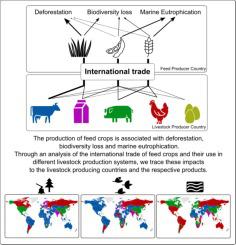当前位置:
X-MOL 学术
›
Glob. Environ. Chang.
›
论文详情
Our official English website, www.x-mol.net, welcomes your
feedback! (Note: you will need to create a separate account there.)
A global multi-indicator assessment of the environmental impact of livestock products
Global Environmental Change ( IF 8.6 ) Pub Date : 2024-07-03 , DOI: 10.1016/j.gloenvcha.2024.102853 Giorgio A. Bidoglio , Florian Schwarzmueller , Thomas Kastner
Global Environmental Change ( IF 8.6 ) Pub Date : 2024-07-03 , DOI: 10.1016/j.gloenvcha.2024.102853 Giorgio A. Bidoglio , Florian Schwarzmueller , Thomas Kastner

|
Driven by a growing and more affluent population, changing diets and lifestyles, the demand for livestock products is expected to surge in the next decades. Satisfying this demand will result in additional pressures on land systems. The increasingly globalized supply chains of the livestock economy will further decouple many of these impacts from the places where livestock are reared. In this study, we determined the impact intensities of global livestock production across three environmental indicators: deforestation, biodiversity loss and marine eutrophication. To this end, we used global data on the production of crops (and grass), their trade and use as feed in livestock-production systems, as well as livestock production data. We found the highest deforestation and biodiversity impact intensities in the tropics in Central and South America, Southeast Asia and Central Western Africa. In contrast, the highest values for marine eutrophication intensities were found in countries located in Northern Europe and in South and in East Asia. Our analyses show differences caused by varying efficiencies in livestock production systems and by the sourcing patterns of feed items. In grazing systems for the production of ruminant meat, for example, the resulting impact intensities are dominated by the consumption of grass. In intensive and industrialized production systems, the bulk of the deforestation and, to a lesser extent, biodiversity impacts are linked to imported soybean feed. Our results can help identify livestock production systems and countries that would qualify as priority action targets, as well as potential entry points to make their livestock production systems more sustainable. They can also be used to assist consumers in comparing impacts across and within livestock food product types. Ultimately, understanding the environmental impacts embodied in global supply chains of livestock products can help create better regulatory policies and science-based interventions for protecting terrestrial and marine ecosystems.
中文翻译:

畜产品环境影响的全球多指标评估
在人口增长和富裕、饮食和生活方式改变的推动下,未来几十年对畜牧产品的需求预计将激增。满足这一需求将给陆地系统带来额外的压力。畜牧经济供应链日益全球化,将进一步将许多影响与畜牧养殖地脱钩。在这项研究中,我们确定了全球畜牧生产对三个环境指标的影响强度:森林砍伐、生物多样性丧失和海洋富营养化。为此,我们使用了有关农作物(和草)生产、其贸易和牲畜生产系统中饲料用途的全球数据,以及牲畜生产数据。我们发现中南美洲、东南亚和中西非的热带地区森林砍伐和生物多样性影响程度最高。相比之下,海洋富营养化强度最高的国家位于北欧、南亚和东亚。我们的分析表明,畜牧生产系统的不同效率和饲料的采购模式造成了差异。例如,在生产反刍动物肉的放牧系统中,所产生的影响强度主要由草的消耗决定。在集约化和工业化生产系统中,大部分森林砍伐以及较小程度的生物多样性影响都与进口大豆饲料有关。我们的结果可以帮助确定畜牧生产系统和有资格作为优先行动目标的国家,以及使其畜牧生产系统更具可持续性的潜在切入点。 它们还可用于帮助消费者比较畜牧食品类型之间和内部的影响。最终,了解全球畜牧产品供应链所体现的环境影响有助于制定更好的监管政策和基于科学的干预措施,以保护陆地和海洋生态系统。
更新日期:2024-07-03
中文翻译:

畜产品环境影响的全球多指标评估
在人口增长和富裕、饮食和生活方式改变的推动下,未来几十年对畜牧产品的需求预计将激增。满足这一需求将给陆地系统带来额外的压力。畜牧经济供应链日益全球化,将进一步将许多影响与畜牧养殖地脱钩。在这项研究中,我们确定了全球畜牧生产对三个环境指标的影响强度:森林砍伐、生物多样性丧失和海洋富营养化。为此,我们使用了有关农作物(和草)生产、其贸易和牲畜生产系统中饲料用途的全球数据,以及牲畜生产数据。我们发现中南美洲、东南亚和中西非的热带地区森林砍伐和生物多样性影响程度最高。相比之下,海洋富营养化强度最高的国家位于北欧、南亚和东亚。我们的分析表明,畜牧生产系统的不同效率和饲料的采购模式造成了差异。例如,在生产反刍动物肉的放牧系统中,所产生的影响强度主要由草的消耗决定。在集约化和工业化生产系统中,大部分森林砍伐以及较小程度的生物多样性影响都与进口大豆饲料有关。我们的结果可以帮助确定畜牧生产系统和有资格作为优先行动目标的国家,以及使其畜牧生产系统更具可持续性的潜在切入点。 它们还可用于帮助消费者比较畜牧食品类型之间和内部的影响。最终,了解全球畜牧产品供应链所体现的环境影响有助于制定更好的监管政策和基于科学的干预措施,以保护陆地和海洋生态系统。






























 京公网安备 11010802027423号
京公网安备 11010802027423号